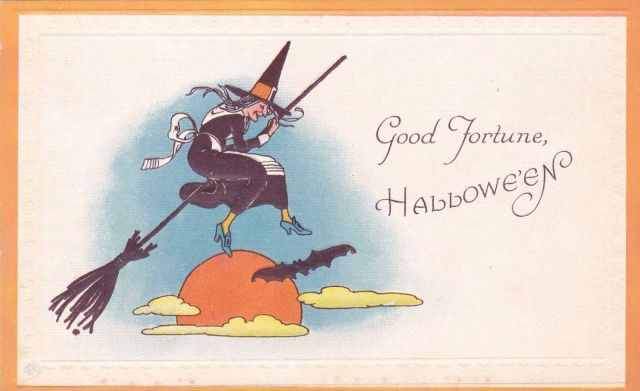
One hundred years ago, Halloween was about…love? ❤
~*~
Maidens their fate may tell on this Hallowe’en.
Of him they love so well learn on this Hallowe’en.
Learn what his trade may be,
If he’ll be true to thee.
Maybe his face they’ll see, this mystic Hallowe’en.
Haste where candles burn, this mystic Hallowe’en.
Come, try thou every charm,
Bravely face each alarm.
Fair maid ne’er came to harm, on a mystic Hallowe’en.
–partial poem from The Complete Hallowe’en Book, circa 1915.1
~*~
Who will you marry, and when? What will be the occupation of your future spouse? Will you be rich or poor? Will they remain faithful, or leave you for someone else? Or will you remain alone forever?
These were the kinds of questions that young people of the past spent Halloween night desperately trying to answer—and if any of you dear readers try some of these fortune-telling games tonight, you may learn your own romantic fate as well! 😉
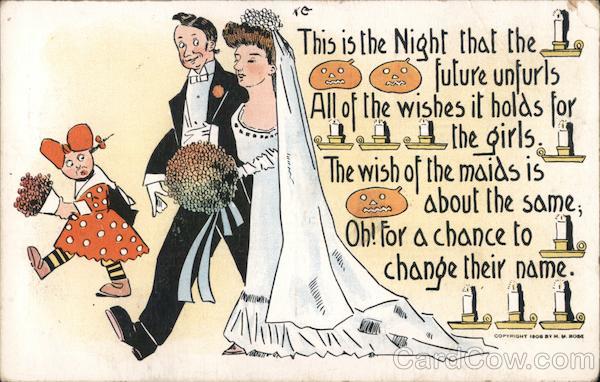
This 1910s or 1920s postcard indicates how much Halloween rituals were still about love and matchmaking. Photo source: cardcow.com
~*~
HALLOWEEN IS “LOVE’S OWN EVE”
Instead of candy, costumes, ghosts and goblins, back in the 19th and early 20th centuries, Halloween was really about one thing: love! ❤
Specifically, if you were a young person, it was about finding out who you were destined to marry. A short story by early romance writer Laura Jean Libbey from 1901, which appeared in the Chicago Tribune, captured this attitude towards Halloween rather well, particularly regarding young women:
“…Halloween, night of all nights, when goblin witches and all things uncanny step slowly forth, when the darkness of night gathers, and hold high revelry under the light of the moon, which hides her face now and then to laugh. Even the stars wink an eye, the waves dance, and the winds whistle gleefully to see the elves of the air flirting with audaciously with Cupid. This is love’s own night, the night maidens challenge Cupid, to find out if there is to be marriage for them within the next twelvemonth, or still another year of waiting for the hero who is to crown their hearts with love’s jeweled diadem and clasp their hands in wedded bliss. This is the night of all nights when youths and maidens take their fling of mirth and fun, just as their grandparents and grandmamas did when they were young, and eyes strive to peep into the mysteries of the future.”2
While it might seem odd today to think of Halloween as full of swooning lovers, this is less surprising when one takes into account the early history of Halloween in America, as well as its previous associations in Europe.
When Halloween arrived in the Colonies, it combined with earlier harvest traditions in ways that emphasized romantic fortune-telling above all else. For example, one popular Colonial tradition during fall was a “play party,” a non-denominational event for farming communities where people got together to have fun and enjoy the fruits of the harvest.3 Such gatherings were a rare opportunities for young folks from far-flung communities to look for a husband or wife. As a result, fortune-telling games like apple bobbing were a popular part of these festivities, where “whoever could snag an apple from a big bucket full of water, hands tied behind the back, would be wed soonest.”4
This association, however, really began in Europe. As Lisa Morton notes in Trick or Treat: A History of Halloween, “marriage was probably the most important event in the life of a rural, pre-industrial young person,” and to that effect, many other earlier European holidays—like May Day—also involved fortune-telling games that could predict marriage.5 Over time, however, these traditions ended up migrating to Halloween. In Scotland, fortune-telling games were already a well-established part of the holiday by at least 1785, when the Scottish poet Robert Burns refers to a number of divination practices, such as burning nuts, throwing yarn and pulling kale in his poem “Hallowe’en.”6 The mystical divination aspect of Halloween, however, is even older than that. According to Lesley Bannatyne in Halloween: An American Holiday, An American History, divination ultimately began as a “Celtic practice” thanks to Druids foretelling the future during Samhain using animal entrails and natural omens.7 Thus, many “quaint” Halloween divination practices involve the elements—fire, water, wind and earth—as well as common sources for them, such as hearth fires, running water, candles, wells, apples and nuts.8
Whatever their origins, in America, the Victorian age reinforced the holiday’s association with young lovers. In America, Halloween was deliberately “subdued, to be made safe for…adults and children” in keeping with ideals of middle class Victorian morality, especially regarding courting; romantic fortune-telling games were a fun way to tantalize young men and women while still keeping things relatively chaste.9 This attitude was reinforced by mass-market publications like Ladies Home Journal, where Halloween was turned into a holiday of “delicious mystery” that was “primarily known for its divination games.”10 Victorian dime novels particularly loved employing these games as plot devices, with many a heroine finding themselves eating “apples at midnight on Halloween while looking into a mirror for the face of a future husband” or following “balls of unwound yarn to dark barns and cellars” only to “fall helplessly into the arms of some gallant hero” who was destined to be their husband.11 A multitude of new “historic” divination games were invented during the Victorian age as well, as “old Halloween rites were given new twists and those twists spawned new games.”12
By the early 1900s, these party games were still going strong. This is very clear when one looks at Halloween postcards from the time period, many of which refer to or depict various fortune-telling activities. Take a look at these examples from Cardcow.com:
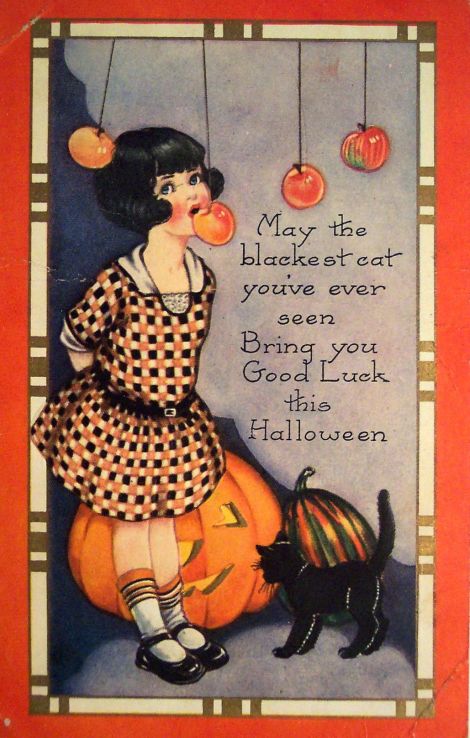
This little girl is playing a variant of “snap-apple,” another popular Halloween game that was similar to apple bobbing. Photo source: cardcow.com
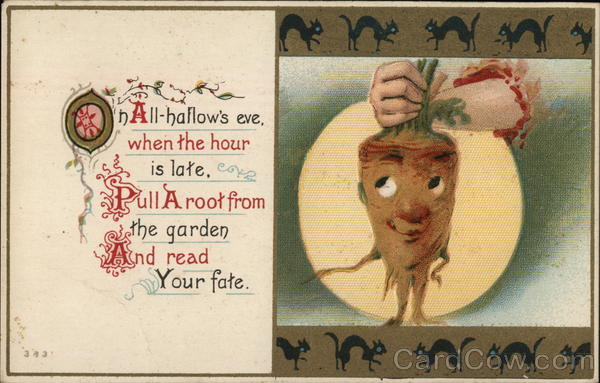
Another popular American game was turnip or cabbage pulls, where young couples would pull up vegetables from a field at midnight on Halloween to predict aspects of their future mate. This game comes from Ireland and Scotland, where the vegetable was usually a stalk of kale or cabbage stolen from a neighbor’s garden. Photo source: cardcow.com
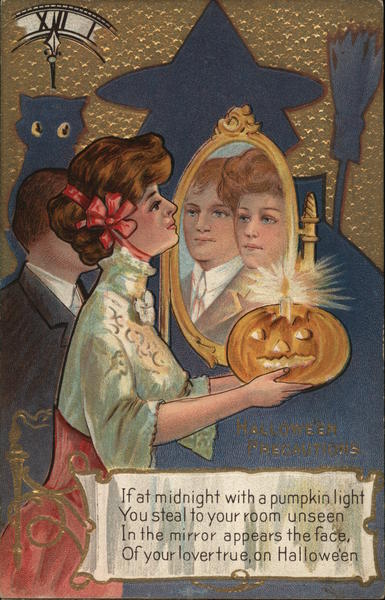
This girl is performing a mirror test with a candle, another popular divination game—and the man to her left is doing his best to tip the scales in his favor. Photo source: cardcow.com
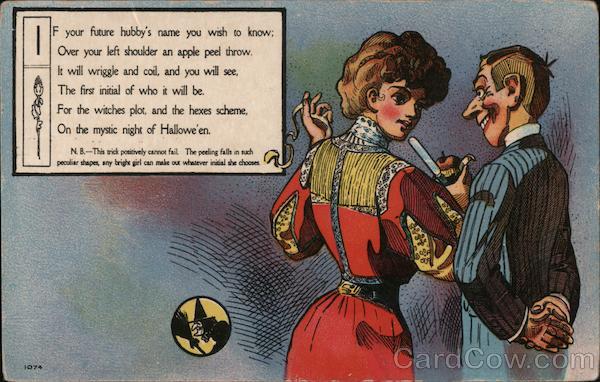
This card comes with instructions for how to perform the apple peel test, as well as your likely outcome (hope hers doesn’t involve the creepy man next to her!). Photo source: Cardcow.com
~*~
Divination games imported directly from Ireland and Scotland, such as the “three luggies,” or three bowls test, were also very popular. As David J. Skal notes in Death Makes a Holiday, “countless [post]cards [of the 1900s] show young women performing…a divination game involving three bowls, or ‘luggies,’ one empty, one containing clear water, and the last containing foul or soapy water, or simply dirt. A blindfolded player would approach the bowls and dip her fingers into one. The clear water represented a virginal mate, the cloudy water or dirt represented ‘damaged goods,’ and the empty bowl the barren fate of a spinster or bachelor”.13 This would be done three times in a row in order to determine the final outcome of the test.14
Such meanings, however, are subject to interpretation—as are the contents of each bowl, which has many different variations, each with a different meaning. Bannatyne, for instance, says the clouded water foretells widowhood, and she also offers a pioneer variant on the game, with bowls full of apples (standing for good luck, wealth, or love), nuts (no change in luck), or soot (sickness and loss of love).15 Hostess guides from the time period offer different interpretations as well. Dame Curtsey’s Book of Novel Entertainments for Every Day in the Year (1911), for example, says the bowls should be filled with water, milk, and nothing. If she touched water she will marry a bachelor, milk a widower, and if her hand comes up empty, she is “fated to remain single.”16 Another American version features bowls of earth, water, a ring, and a rag. The earth meant divorce, water a journey across the ocean, the ring a trip to the altar, and the rag no marriage at all.17
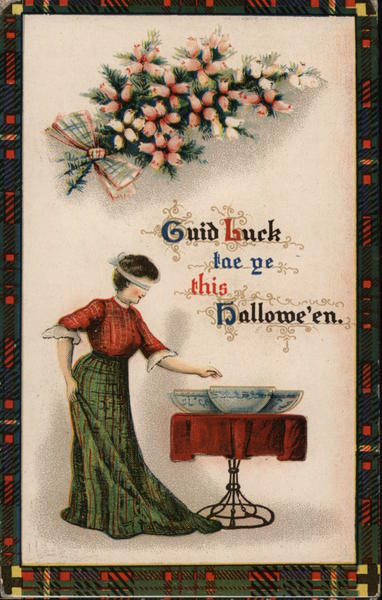
A woman preparing to test her luck with the fateful luggie bowls. Source: cardcow.com
Interestingly, variations of the Three Luggies test were being performed as late as the 1940s in America. During WWII, a wartime version of this game consisted of blindfolded girls selecting one of seven bowls, each filled with a different item connected to the military: “red cloth…indicated they would marry an army man and a blue cloth, a sailor.”18 Another version had bowls “filled with red, white and blue-colored water and named for different branches of the armed services; thus a girl might discover the military affiliation of her future beloved.”19
Regardless of their origins, these fortune-telling games were enjoyed by Jazz Age party goers as well. For example Doris Blake, Chicago Tribune reporter, offered a long list of many of the games just mentioned—the same list she’d been offering, more or less, since 1910. This was because they livened up a party considerably in spite of their age. Even the Bogie Book, those ubiquitous party planning books of the 1920s, agrees: “although a few new and untried games may be interspersed on Hallowe’en, the old ones that have been handed down are the very life of the celebration and must never be omitted“.20 Besides, “no Hallowe’en party is considered a success unless all have bobbed for apples, each girl has walked down stairs backwards mirror in hand to catch a glimpse of her future husband, walnut shell boats have sailed in a tub of water, and apple parings flung over the left shoulder have formed a letter as they fall to the floor.”21
So, if you’re looking to add unique to your Halloween party this year, dear readers, why not get together with some of your friends at the Witching Hour and try your hands at some of these tests and games?
~*~
FORTUNE-TELLING WITH APPLES, NUTS AND FIRE:
Apples and nuts, particularly chestnuts and walnuts, were popular divination tools during Halloween. While both were obviously “plentiful at harvest time,” there may be other reasons for their popularity as well.22U To this day, many sources cite the possibly fictional Roman festival of Pomona as another reason for this particular association. Considered the goddess of orchards, seeds and the harvest, Romans supposedly sacrificed apples and nuts to Pomona on November 1st, and this festival may have combined with Druidic Samhain rituals in England to “give later generations the charms and omens that come from nuts and apples which are made trial of at Hallowe’en.”23 Just as popular, nuts were also an important part of divination rituals. In Scotland and northern England, nut games were such an important part of the celebrations that the evening was known as “Nut Crack Night.”24
Whether or not ancient Rome was involved, however, these games are still pretty fun. So why not grab a few apples and try them yourself, dear readers…if you dare! 😉
~*~
~ APPLE PEEL LETTERS ~
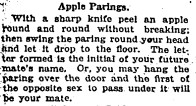
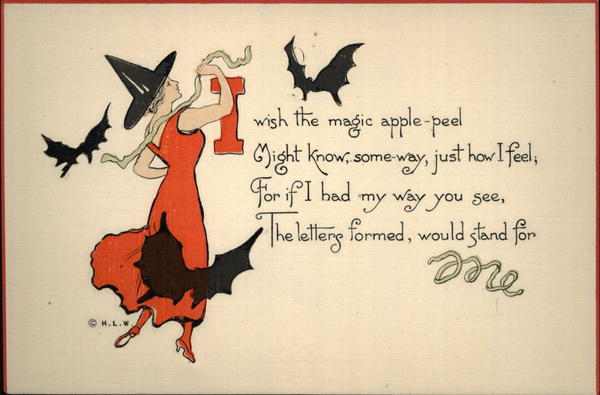
Image source: Cardcow.com
As you peel your apple, there a number of rhymes you can recite as well. This one comes from John Gay’s 1714 poem The Shepard’s Week:
“I pare this pippin round and round again,
My sweetheart’s name to flourish on the plain;
I fling the unbroken paring o’er my head,
My sweetheart’s letter on the ground is read.”25
This one comes from Diane Arkin’s book Halloween: Romantic Art and Customs of Yesteryear:
By this magic paring I wish to discover,
The first letter of the name of my true lover.
Three times around with movement slow,
Then upon the floor lie low;
Show me, if you know the same,
The letter of my true love’s name.26
If no letter can be determined from the peeling, then it is assumed that the inquirer will not marry—however, a “bright girl” could usually make out any letter she chose, if she was clever enough, and thus use the test to her advantage.27
~*~
~ FLAMING WALNUT BOATS ~
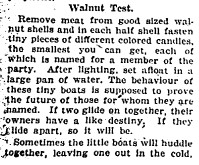

~*~
~ COUNTING APPLE SEEDS ~

There are quite a lot of variants on what the number of seeds mean, but here a few different interpretations from various poems:
One seed means “a journey,” “an enemy,” or “you’ll get a letter”
Two seeds mean wealth, “a new friend,” an early marriage, or “you’re going to break”
Three seeds mean true love, “your luck is going to mend,” a legacy, or “you’ll hear some good news”
Four seeds mean health, “a short sickness,” great wealth or “a ride you soon will take”
Five seeds mean a quarrel, “new clothes,” a sea voyage, or “you will be disappointed”
Six seeds mean “a pleasant journey,” “great fame as a orator or singer,” or “you’ll meet a friend”
Seven seeds mean marriage, “a lovers’ quarrel,” “possession of an item most desired,” or “a surprise”
Eight seeds mean “a new name,” “twice you’ll wed,” or “some money you will spend”
Nine seeds mean travel, “a long life before you’re dead,” or “there’s pleasure coming”
Ten seeds mean a ring, “you’ll be happy,” or “you’ll have something to wear”
Eleven seeds mean a fortune, “riches galore,” or “you will take a trip”
Twelve seeds mean four children, or “some good luck you will share”
Thirteen seeds mean honor, or “you’ll have a fright”
Fourteen seeds mean “a good name” or “your future days are bright”
Fifteen seeds mean “political fame.”28
~*~
~ BURNING NUTS ~
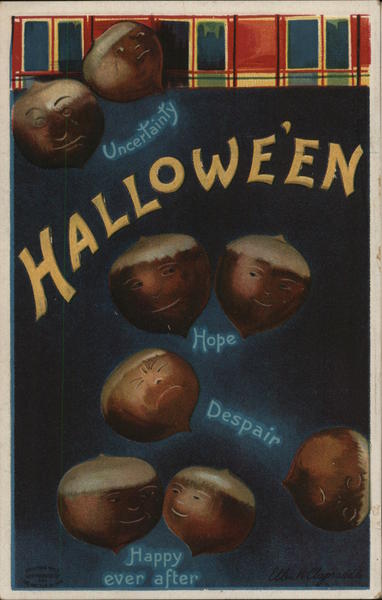
A visual sum-up of the nut test, where the actions of your nuts foretell your future relationship. Photo source: cardcow.com
A popular old game that stretches back to at least the early 1700s, this test can be performed with either walnuts or chestnuts.
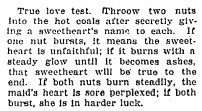
~*~
~ APPLE SEEDS ~
Apple seeds, if applied to the face, can determine the steadfastness of your lover:

For a variation on this game, you can recite this verse as you apply each seed:
“Pippin, pippin, I stick thee there
That thou is true thou mayest declare.”29
~*~
~ RAISIN RACE ~

~*~
~ SNAP APPLE, WITH AND WITHOUT CANDLE ~
Suspend a series of apples from the ceiling with string or ribbon, tying the string to the stems. Blindfold all players and have them bite at the apples. The first who successfully bites an apple—something which is much harder than it looks—will “be the first to marry.”30
For a more daring variant, try this little number from the early 1900s. According to a 1907 edition of Harper’s Bazaar, this particular game was loads of fun, especially when “the candle flame brushed noses and chins in the sauciest manner”31:
“The apple and candle game is another favorite sport. From the ceiling a strong cord is suspended and is tied to the center of a stick about two feet long. To one end of this stick an apple is fastened; to the other end a lighted candle. The string is set in motion, and contestants try to catch the apple with their teeth [with hands bound behind their back]…[if you want to be safer,] instead of a candle, a bag of some thin material, filled with flour, may be substituted…three attempts to catch the fruit, with failure each time, is a fatal blow to all hopes of a speedy marriage.”32
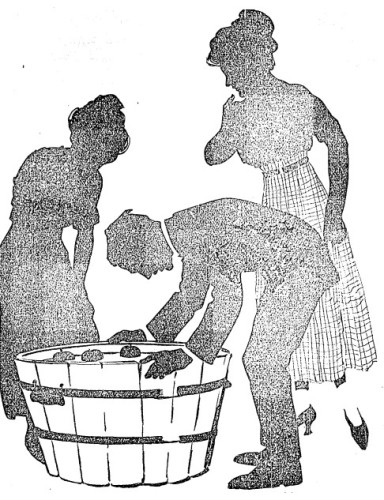
Apple bobbing was another fun pastime that could be used to predict future sweethearts. Either initials were carved into the back of the apples or small tags with names were attached to the stems. Whoever you drew from the bucket was destined to be your love. If done as a group, whoever got the first apple would marry within the year. If the apple was caught on the first attempt, then the lover was seen as true, while more slippery apples were seen as fickle lovers or no worth pursuit from the bobber.
~*~
FORTUNE-TELLING WITH HOUSEHOLD OBJECTS AND PLANTS:
Besides fruits and nuts, various everyday objects could also be turned into fortune-telling tools. Bowls, water, eggs, needles, candles, and plates all feature in these easy tests to help men and women find their true loves.
~*~
~ THE NEEDLE AND THE BOWL ~

~*~
~ THE RING AND THE GLASS ~

~*~
~ JUMPING THE CANDLE ~

~*~
~ THREADING THE NEEDLE ~

~ THE WELL ~
This test from Ireland was popular throughout the Midwest after it was brought over by Irish immigrants:
“Lie down on your back by a well on Halloween and hold a mirror over your head so that you can see a reflection of the bottom of the well. If you are to marry, the picture of your future marriage partner will appear in the mirror.”33
~*~
~ THE FOUR PLATES ~
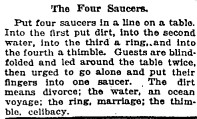
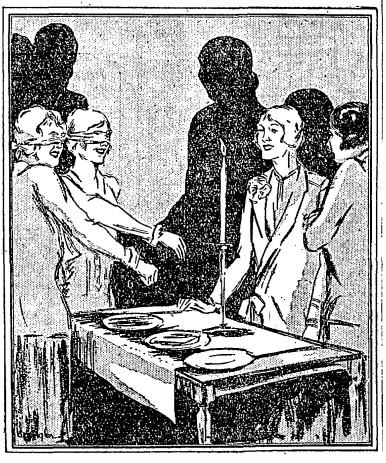
1920s party guests ready to play the Four Saucers game, a variant on the more traditional Luggie Bowls.
~*~
~ THE YARN TEST ~
For this test, one needs a barn or cellar and a ball of yarn. The person throws the ball into the barn or down the cellar stairs so it unravels, all while holding onto the other end of the string. Then the person begins rolling it up until it catches on something. When it does, one is supposed to ask “Who holds?” Either the wind will whisper the name of your future spouse, or their spectre will appear behind you to wind up the ball.34
Alternatively, one could throw the ball of yarn and repeat one of these chants as they wound it up:
I wind, I wind, my true love to find
The color of his hair, the clothes he will wear
The day he is married to me.35
Or:
Whoever will my husband be
Come wind this ball behind of me.36
~*~
~ PULLING CABBAGE ~
In Scotland, Ireland, and England, this test was done with kale, leeks, or cabbages. Romantics would go out hand in hand to pull vegetables from the garden at midnight while blindfolded; the attributes of the selected vegetable would determine aspects of your future mate. How easily or difficult the stalk was to pull indicated how easily your mate would be to win. After that, the shape and condition of the vegetable denoted various aspects: a full, green head symbolized an attractive mate, while a closed white stalk was old or stingy; dirt on the roots meant wealth while clean roots meant poverty; the flavor of the plant, whether sharp, sweet, or “insipid” foretold your mate’s disposition, and the shape, whether tall, stout, bold or graceful, denoted the mate’s “physical build.”37
~*~
~ ROSE TEST ~
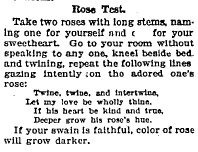
~*~
~ THE PUMPKIN SEER ~
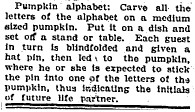
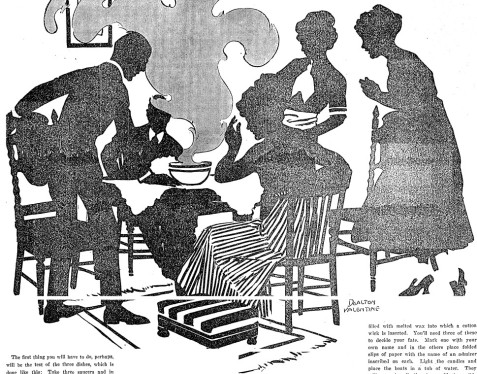
A group gathers around for what is probably an egg white or molten lead test. During the test, hot lead or egg whites are poured into a bowl of cold water, and the shapes made by the material as it hardens are interpreted to determine the future.
~*~
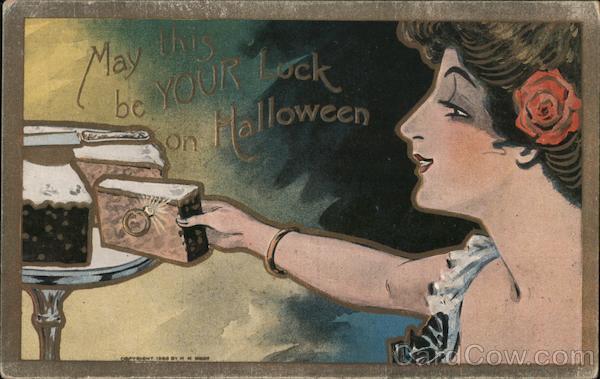
This 1910s postcard refers to another form of fortune cake: bake a wedding ring into a cake, and whoever gets the slice with the ring is destined to marry within the year. Photo source: cardcow.com
FORTUNE-TELLING WITH PROPHETIC DREAMS, VISIONS, AND CAKE:
Halloween night, when the spirit world comes closer to ours than any other point in the year, is also supposed to be great for prophetic visions or dreams. In this section, mirrors, candles, cake and trinkets to put under your pillow are sure to induce visions of love…
~*~
~ MIRROR, MIRROR ~
There are a wide variety of mirror tests, many of which also involve candles. Here are a few:
- “A girl who sits before a mirror at midnight on Halloween combing her hair…will see the face of her true love reflected in the glass.”38
- Hold a mirror in one hand and a lit candle in the other. Walk backwards out the door at midnight while reciting a rhyming verse. Some possibilities:
“Round and round, O stars so fair!
Ye travel, search out everywhere.
Whoever she meets or runs into while walking backwards will be her future husband.
- Stand in front of a mirror at midnight in a candlelit room and eat an apple. If your lover loves you back, their spurt will appear in the mirror and ask for the last bite.40
- Walk backwards down the cellar or basement stairs while holding a mirror. Behind you, in the glass, you should “catch the features of your [future] mate.”41
~*~
~ THE FLOUR CAKE ~
“Tightly pack a bowl with flour and insert a ring vertically into some part. When the bowl is full, invert it onto a plate and invite fortune-seekers to cut a thin slice from the mound using a sharp knife. The guest whose slice contains the ring will be the first to marry.”42
~*~
~ DREAM A LITTLE DREAM… ~
There were a wide variety of ways to induce dreams of your future spouse on Halloween night. Here are a few ideas:
- Place bay leaves under your pillow at night if you’re a man, or rosemary if you’re a woman, and you will dream of your future lover.43
- Remove the yolk from a hard boiled egg, fill the cavity with salt, and eat it before going to bed without drinking any water. You will dream that your future lover will bring you water.44
- Make small pills of grated walnuts, hazelnuts, nutmeg, butter and sugar and eat them before bed, and you will learn your future husband’s occupation. If you dream of gold, he will be rich; of noise, he will be a tradesman; of thunderstorms, he will be a traveler.45
- Rub each of your bedposts with a piece of lemon, and your lover should appear to you at night in a dream to bring you two lemons.46
- Before going to bed on Halloween night, place a glass of water on your nightstand and add a sliver of wood to it while repeating this rhyme: “Husband mine that is to be, come tonight and rescue me.” During the night if you dream of falling from a bridge into a river, your future mate will come and rescue you in your dream.47
- “Write the names of three sweethearts on slips of paper and put them beneath your pillow. If you dream of one of those named, you can be assured that person cares for you. If his is the name you draw out first in the morning, he will be the one you marry.”48
Walk out the front door backwards at the stroke of midnight on Halloween and pick three blades of grass. Wrap them in orange paper and tuck them under your pillow, thus ensuring whatever you dream that night will come true.49
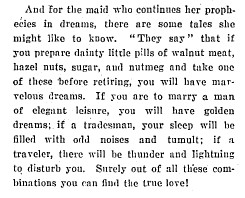
This recipe for “dream pills” comes from a 1915 Chicago Tribune article, but there are many variations.
Alternative interpretations for the dream pills are: pleasant dreams mean you’ll marry a gentleman, difficult dreams mean you’ll marry a laborer, and dreams of storms mean you’ll marry a ne’er-do-well or a rogue.50
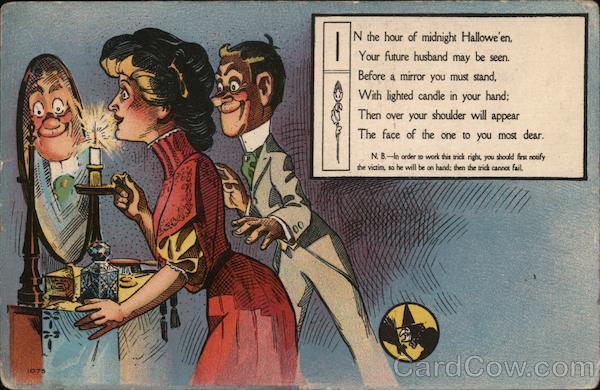
This young couple is performing a mirror test…which this fellow is obviously influencing to his advantage. Image source: Cardcow.com
~*~
Looking to add even more games and fortunes to your vintage Halloween party? Then try Halloween Happenings (1921) by Lettie Van Derveer. It’s full of even more fortune-telling games and tests and is suitable for any Roaring Twenties Halloween party, although most of the games require some assembly beforehand on the part of the host, particularly in writing out all the fortunes. Many of the games appear to have been invented for the sake of the book as well, so they’re definitely examples of period activities.
Another possibility is the “Games of Fate” section of Hallowe’en Festivities (1903) by Stanley Schell (1903). While this resource is technically older than the Roaring Twenties, many of the games I’ve listed here are described in it as well, plus many more.
~*~
So what about you, dear readers? Will you try any of these games tonight? If so, dear readers, I’d love to know what the fates foretold for you, so please come back and share in the Comments! And whatever you do this year, dear readers, I hope you have…
…a Happy Halloween! 😀
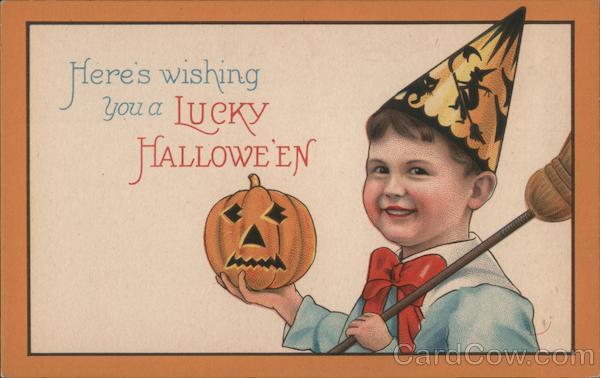
~*~
Works Cited Within Text:
1. Arkins, Diane C. Halloween: Romantic Art and Customs of Yesteryear. Gretna: Pelican Pub, 2000. 11.
2. Libbey, Laura Jean. “All Halloween is Love’s Own Eve.” Chicago Daily Tribune (1872-1922), Oct 31, 1910. https://search.proquest.com/docview/173564143?accountid=3688.
3. Bannatyne, Lesley Pratt. Halloween: An American Holiday, And American History. New York, NY: Facts on File, 1990. 53.
4. Bannatyne, Halloween, 56.
5. Morton, Lisa. Trick or Treat: A History of Halloween. London, UK: Reaktion Books, 2012. 37.
6. Ibid.
7. Bannatyne, Halloween, 71.
8. Bannatyne, 72.
9. Bannatyne, 105.
10. Bannatyne, 107.
11. Bannatyne 114
12. Bannatyne,115.
13. Skal, David J. Death Makes a Holiday: A Cultural History of Halloween. New York : Bloomsbury, 2002. 39.
14. Paull, Marion. Creating Your Vintage Hallowe’en: The Folklore, Traditions, and Some Crafty Makes. New York, NY: CICO Books, 2014. 118.
15. Bannatyne, 57.
16. Glover, Ellye Howell, 1868-. “Dame Curtsey’s” Book of Novel Entertainments for Every Day In the Year. 7th ed. Chicago: A. C. McClurg & co., 1911. 98.
17. Paull, Vintage Hallowe’en, 118.
18. Bannatyne, 131.
19. Morton, Trick or Treat, 65-66.
20. Dennison Manufacturing Company. The Bogie Book. 1922. 12.
21. Dennison Manufacturing Company. The Bogie Book. 1923. 35.
22. Bannatyne, 57.
23. Kelley, Ruth Edna. The Book of Hallowe’en. Boston: Lothrop, Lee & Shepard co, 1919. 26.
24. Bannatyne, 57.
25. Morton, 55.
26. Arkins, 24.
27. Ibid.
28. Arkins, 27-29.
29. Bannatyne, 72.
30. Arkins, 22
31. Arkins, 23.
32. “SPELLS for ALL HALOWEEN.” Chicago Daily Tribune (1872-1922), Oct 26, 1902. https://search.proquest.com/docview/173111478?accountid=3688.
33. Bannatyne, 75.
34. Paull, 113.
35. Bannatyne, 75.
36. Bannatyne, 72.
37. Arkins, 41.
38. Kelley, 162.
39. Ibid.
40. Schell, Stanley. Hallowe’en Festivities. New York: Edgar S. Werner Pub. & Company, 1903. 52.
41. Blain, Mary E., 1872-. Games for All Occasions. Chicago: Brewer, Barse & co, 1909. 23.
42. Arkins, 61.
43. Paull, 117.
44. Ibid.
45. Ibid.
46. Arkins, 53.
47. Arkins, 54.
48. Ibid.
49. Ibid.
50. Arkins, 57.
Please note: The tests pictured in this post, as well as the black and white illustrations, are taken from the following Chicago Tribune articles, in no particular order:
Blake, Doris. “Love Superstitions for Hallowe’en.” Chicago Daily Tribune (1872-1922), Oct 24, 1915. https://search.proquest.com/docview/173969438?accountid=3688.
Blake, Doris. “Hallowe’en Superstitions.” Chicago Daily Tribune (1872-1922), Oct 22, 1922. https://search.proquest.com/docview/174950181?accountid=3688.
Blake, Doris. “Hallowe’en Lore.” Chicago Daily Tribune (1923-1963), Oct 28, 1928. https://search.proquest.com/docview/180954597?accountid=3688.
Blake, Doris. “HALLOW-E’EN LORE.” Chicago Daily Tribune (1872-1922), Oct 24, 1920. https://search.proquest.com/docview/174749541?accountid=3688.
Blake, Doris. “Halloween Superstitions: They’re Not to be Taken Seriously, but They Provide a Lot of Fun for a Party.” Chicago Daily Tribune (1923-1963), Oct 30, 1927. https://search.proquest.com/docview/180814682?accountid=3688.